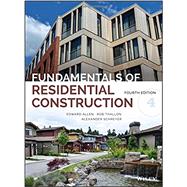The leading guide to professional home construction, updated and expanded
Fundamentals of Residential Construction is the definitive guide to single family and multifamily home building that details every step of the construction process. From siting and foundations to finishing details, this book provides a complete walk-through of professional home construction. Over 1,200 drawings and photographs animate the textbook, while interactive supplementary online resources help facilitate an understanding of the material. This fourth edition accommodates the latest developments in materials and methods, including new coverage of sustainable building and energy efficiency, multifamily construction, prefabricated building components, and CAD/BIM planning tools in residential construction. Authoritative coverage of wood light-frame construction, building systems, industrialized fabrication, insulating concrete forms, light-gauge steel and masonry construction, multi-family buildings, and more provides a solid foundation in residential construction methods, tools, and processes.
Building a home requires a deeply integrated understanding of materials, structures, codes, and management procedures. Because the process involves such a broad array of considerations and challenges, construction professionals must regularly draw on a clear body of knowledge to keep a project running smoothly. This book helps you lay the groundwork of expertise required to successfully complete a residential project.
• Learn the advantages and disadvantages of common materials and systems
• Understand site preparation, foundations, and framing
• Delve into the details of roofing, finishing, and energy efficiency
• Understand heating/cooling, plumbing, and electrical options
• Examine the latest codes, costs, and management best practices
Designing and constructing a home presents a unique project dynamic; people's homes are their sanctuaries, where they make the memories of a lifetime. They must be designed to be lived in, not simply "used." Lifetime costs play a major role in decision-making, materials must be carefully chosen and sourced, and spaces must be structured to be efficient yet enjoyable. Fundamentals of Residential Construction shows you how to bring it all together to turn a project into a family's cherished home.









